- Italy Tours Home
- Italy Ethos
- Tours 2023
- Blog
- Contact Us
- Dolomites
- Top 10 Dolomites
- Veneto
- Dolomites Geology
- Dolomiti Bellunesi
- Cortina
- Cadore
- Belluno
- Cansiglio
- Carso
- Carnia
- Sauris
- Friuli
- Trentino
- Ethnographic Museums
- Monte Baldo
- South Tyrol
- Alta Pusteria
- Dobbiaco
- Emilia-Romagna
- Aosta Valley
- Cinque Terre
- Portofino
- Northern Apennines
- Southern Apennines
- Italian Botanical Gardens
- Padua Botanical Garden
- Orchids of Italy
Bologna Botanical Garden: a Most Historic Institution of this Kind in Italy.
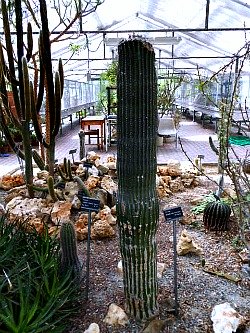
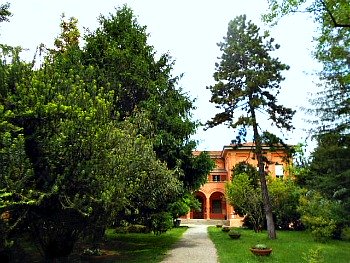
General Presentation
The main elements underlying the structure of the Bologna Botanical Garden are single collections of high value and the reconstruction of natural habitats. With regard to the collections, the most noteworthy one is undoubtedly that of succulent plants (see an image above). It is one of the largest in Italy, and it was created in the first half of the 20th century thanks to the efforts of Giuseppe Lodi, then Professor of Botany. Two other glasshouses in the garden contain tropical plants, amongst which are some beautiful epiphytic orchids, and several European and exotic carnivorous plants.
Outdoors, the front part of the garden on via Irnerio (second picture above) is partially ornamental but it also hosts numerous trees and bushes of scientific and educational interest. The largest portion of the garden, extending at the back of the buildings of the Biology Department up until the old bastions of the city, is dedicated to the recreation of natural habitats; it also displays an area devoted to medicinal plants (a reconstruction of Aldrovandi’s “Garden of the Simples”), two artificial ponds with aquatic plants and a wood consisting mainly of broadleaved species typical of temperate climates. Next to a pond displaying the vegetation of swamps and marshes, a habitat corresponding to the submerged forest of the plains of the river Po has been created.
Along the bastions several other vegetational groups are present: Mediterranean plants of hot and arid zones; species from the forests of warm, low-altitude regions and those from cooler mountain areas (such as the beech grove) of the Apennines around Bologna. Specimens of high-altitude mountain flora and of the typical gypsum outcrops of the hills surrounding Bologna (the Gessi bolognesi) are currently being displayed as well. The main part of the garden is occupied by the Arboretum, which characterises the garden in the different seasons (of which is a general view below).
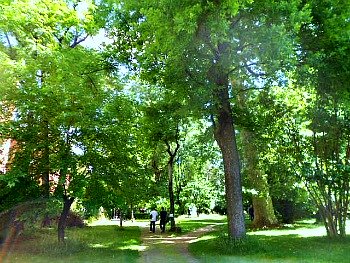
The Origins of the Garden: Introduction
The origins of Bologna Botanical Garden are strictly connected with the early development of botany in Italy. Indeed, ever since the sixteenth century, the University of Bologna was one of the main centres of botanical knowledge in Italy. Luca Ghini (1490-1556) was the first to hold the Chair of Botany, and his tasks in Bologna comprised both lecturing and giving practical demonstrations on plants. Ghini required suitable material for these demonstrations, and therefore asked the local Civic Senate for a place in which to grow his “herbs”. Owing to the Senate’s indifference and to his low salary, Ghini was compelled to accept a good offer from the Grand Duke of Tuscany. He therefore moved to Pisa, where he founded, in 1544, the Botanical Garden of that city. After the departure of Luca Ghini from Bologna, one of his pupils – Ulisse Aldrovandi (1522-1650) – succeeded him. Aldrovandi was successful where Ghini had failed; thus, in 1568, he obtained from the Senate the permission to create in the city centre – in the courtyard of the Public Palace – the first Bologna Botanical Garden, which he himself directed for 38 years, until his death.
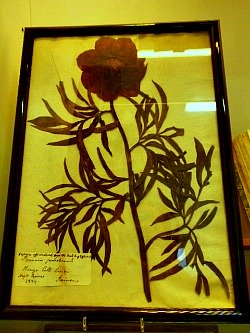
The Origins of Botany in Bologna and in Europe: Luca Ghini and his School
The history of Bologna Botanical Garden and that of the Herbarium of the University – the same that can be visited today at no. 42 of via Irnerio – are strictly connected, as far as their origin is concerned, with the history of Botanical Science in Italy (a specimen of Paeonia from the small Botanical museum contained within the Garden is shown above). Ever since the sixteenth century, the University of Bologna was one of the most important centres for Italian botanical knowledge. Luca Ghini (1490-1556), a well-known scholar of this University, held the Chair of Botany – at that time known as Chair of Herbs. In medieval terminology “herbs” – or rather “herbal principles” – were the drugs directly extracted from the plants. The Chair of Herbs in fact addressed his teaching to medical students, and these two disciplines – medicine and botany – remained united for a long time.
Luca Ghini’s tasks in Bologna were both to lecture and to give practical demonstrations on the herbs (the latter also known as “ostensors”). Ghini required suitable material for these practical demonstrations on the plant species, which his students had to recognise; he therefore asked the Civic Senate for a place where to grow his “herbs”. According to Monti, in Bologna since 1365 there existed a garden in which plants with pharmaceutical properties were grown, but it seems that it was created only for practical purposes and not for teaching. According to Savelli, there were two small gardens: one situated in the Monastery of S. Salvatore, and the other in the Gozzadini estate. Moreover, it seems that Ghini obtained some plants from a private garden that belonged to Paolo Poeta, of whom we have no other information; in any case, these small gardens offered inadequate solutions to the development of botany and to the tasks assigned to Luca Ghini.
Owing to the Senate’s indifference and to his low salary, Ghini was compelled to take a drastic resolution: he accepted a good offer from the Grand Duke of Tuscany and therefore moved to Pisa, where he quickly obtained the indispensable support needed to found, around 1544 (but the exact date is unknown), the Botanical Garden of that city. Nowadays, the Botanical Garden of Pisa is considered the oldest in the world, although this record is challenged by Padua, whose Botanical Garden was founded – as certified by a Senate-decree of the Republic of Venice – on June 29, 1545. Luca Ghini, who later also founded the Florence Botanical Garden, can be considered one of the most important botanists of all times. This famous founder of the Italian School of Botany – teacher of Cesalpino, Mattioli, Aldrovandi and other famous botanists – was also the first author of a herbal in the modern sense, as we owe him the idea of substituting the traditional “drawn herbals” of Medieval times with proper herbals made of real plants – the so-called exsiccata (dried specimens).
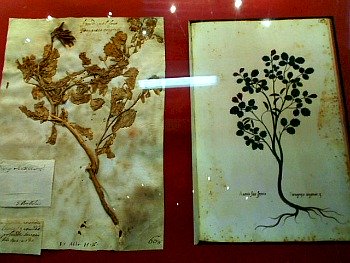
Ulisse Aldrovandi and the Birth of Bologna Botanical Garden
After the departure of Luca Ghini, one of his pupils, Ulisse Aldrovandi (1522-1650), succeeded him. He was an excellent naturalist and one of the most important scientists of the late 16th and early 17th century. Aldrovandi held a prominent position in the scientific world and played a guiding role for the Italian naturalists of the time. His impressive naturalistic collections are still preserved in the Aldrovandi Museum of the University (above, see an image from Aldrovandi’s herbal, side by side with a botanical drawing of the same species; this is also part of a small selection which can be seen in the Botanical museum). Aldrovandi succeeded where Ghini had failed: in 1568 he obtained from the Senate permission to found Bologna Botanical Garden, which then he himself directed for 38 years, until his death.
The original site of the Botanical Garden was in the city centre, in the courtyard of the Public Palace (Palazzo Pubblico), near the hall where Aldrovandi gave his lectures. Little is known about this first “garden” – surely very different from the present one – but it had to be rather small, considering the little space available. Its early location in the Public Palace is witnessed by an epigraph engraved on a cistern, which is a copy of the original one built in 1587 and preserved today in the Academy of Fine Arts. This site, which for Bologna was only temporary, was the first of a series of so-called “botanic courtyards”, which in many other cities remained fixed since the beginning – albeit often restricted in narrow spaces.
From Aldrovandi to Monti
During the 17th century, Bologna Botanical Garden developed along the scheme traced by Aldrovandi, taking into account, however, two fundamental changes: the enormous increase in floral knowledge due to the exploration of new continents and the separation of botany from the medical sciences. Due to the thousands of new species discovered, the need to create a “natural system” was becoming a task of primary importance, and it required a vast cultural effort – indispensable per se, regardless of the practical uses of these plants.
The ships returning from their voyages across the oceans carried not only gold and silver stolen from the New World, but also seeds and dessiccated plants. The former were germinated in the European botanic gardens, while the latter were studied and classified by European botanists. Indeed, even in Aldrovandi’s time, Bologna Botanical Garden was not only a simple collection of medicinal herbs; thanks to the naturalistic interests of its founder, Aldrovandi’s collection included – besides the “herbs”, or simples – many exotic specimens personally collected by him or obtained from correspondents. Consequently, the courtyard of the Public Palace soon became inadequate to host such a growing collection, and in 1587 Bologna Botanical Garden was transferred to a larger site named “Borghetto San Giuliano”, next to present-day Porta Santo Stefano. The number of cultivated plants grew from 800 in 1573 to about 3,000 in 1595; however, because of the considerable distance from the place where the lectures were held, part of the specimens were kept in their original location in order to carry out the “ostensors” (practical demonstrations). The operations were directed by Aldrovandi himself – now an old man – with the help of his pupil Cornelius Wertwer: a Dutchman who succeeded him as Prefect of the Garden after his death.
Traditionally, the post of Professor of Botany and Director of the Bologna Botanical Garden was covered by a single person, next to whom a new position was created for a superintendent, supervisor or curator, with the precise task of managing the garden. Among the important scientists who directed Bologna Botanical Garden were the Ambrosini brothers – Bartolomeo (1588-1657) and Giacinto (1605-1671). Under their direction, the garden became considerably larger: a catalogue of the plants cultivated in the year 1653 lists about 1,500 different species – at the time one of the largest collections in Europe, but also a significant figure for many botanical gardens of today.
From 1722 to 1729, Bologna Botanical Garden was directed first by Giuseppe (1682-1760) and then by Gaetano Monti (1712-1797). Under Giuseppe Monti’s direction the garden was definitely transferred from its original courtyard location to the broader site near Porta S. Stefano. This move took place in 1740 and soon after (in 1745) a “hybernaculum” was built, in which exotic plants were kept during the coldest months of the year. The establishment of a special exotic section reflected both the new tasks assigned to botanical gardens and the new physiognomy they came to have during the 18th century.
This was also a time of thriving botanic research, and many scientists actively collaborated with Bologna Botanical Garden. Amongst them is Ferdinando Bassi, whose activity is also witnessed by several of his specimens contained in the Herbarium (see below an image of a dried specimen displayed in the Botanical Museum). Bassi and other botanists also sent their specimens to Linneaus – perhaps the most famous botanist of all times – with whom they kept in regular contact. It is worth noticing, in fact, that Linnaeus would later honour the memory of the Ambrosini brothers by naming a plant Ambrosinia bassii – where the genus’ name is after the two brothers, while the name of the species reminds precisely of Ferdinando Bassi, who was also in charge of the exotic collections around the middle of the 18th century. Monti too would be paid a homage by Linnaeus, who linked his name to genus Montia. On his part, Linnaeus – as we will soon see – was about to cause a real revolution in the scientific world.
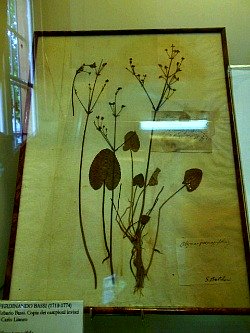
The Linneaen Age
During the course of the 18th century, thanks to the important work of Carl Linnaeus (1707-1778) – Swedish botanist and zoologist – much of the confusion regarding the identification and classification of plants was cleared. In particular, the various systems of classification existing until then were inadequate for the introduction of new species; thus, Linnaeus attained the objectives formerly pursued by Cesalpino and Tournefort in the field of plant systematic. Two important innovations can be ascribed to him: the creation of a “sexual system” – by which plants are subdivided into classes according to the morphology of their reproductive organs – and, most importantly, the introduction of a binomial system of designation of the different species using two Latin names (genus/species) instead of a polynomial one (a phrase that provided a concise description of the species with emphasis on its principal characteristics). As the number of known species increased, the polynomial system became more and more complex and of little practical use. Following a lengthy debate lasted several decades around the middle of the 17th century, Linnaeus’ proposal was finally accepted and put into practice throughout Europe – and the Linnaean binomial system of nomenclature is still used today in the entire biological field.
The botanists in charge of this area of study in Bologna were presumably in direct contact with Linnaeus; this is demonstrated by their use of a binomial nomenclature based on their own names, and certainly Ferdinando Bassi (already mentioned above) was in correspondence with both Koenig and Linnaeus. The polynomial nomenclature probably remained in use until the time in which Luigi Rodati (1763-1832) became Professor of Botany and Prefect of the Garden. He had acquired a profound knowledge of Linnaeus’ works and made great efforts to apply the “sexual system” to reclassify the specimens growing in Bologna Botanical Garden – which, until then, had been classified using Tournefort’s system – and probably also to rename them using the binomial nomenclature. By that time – around 1765 – the garden had an established collection dedicated to exotic plants, several rare trees and more than 400 potted plants, including several valuable species of medicinal use. More information on the Linnaean binomial system is provided below.
Naming plants and animals
In Linnaeus’ times scientists used to name plants and animals in variable ways. The most common species often had a simple name (wheat was ‘frumentum’; chestnut was ‘castanea’ – and so on), but in most cases some other adjective or specification was added, in order to distinguish between similar species (for example, sage was defined as ‘salvia major seu vulgaris’); other names may also have been in use for the same plant. No general accepted rule existed, and each scholar had his own criteria; as a consequence, the same species was given different names, or the same name was sometimes used with a different meaning, thus generating a great confusion.
Linnaeus established a standardized nomenclature rule – the so-called ‘binomial system’. This implied that: 1) all species were gathered into ‘genera’. The genus is the assemblage or gathering of mutually similar species. Each genus had (and still has) its name; for instance, all oaks belong to genus ‘Quercus’; all dogs, wolves and related species belong to genus ‘Canis’, etc.; 2) species within each genus are distinguished by an additional name; Holm oak, for instance, is named ‘Q. ilex’; wolf is called ‘C. lupus’. Each species is indicated by one double (binomial) name, and each binomial name may be used for that one species only, so to avoid any confusion: it may seem obvious to us today, but nobody had had the idea before. Binomial nomenclature has been universally accepted and used ever since, as it preserves scientific communication from confusion and ambiguity.
Linnaeus Classification System
Less than 20,000 plant and animal species were known at Linnaeus’ times. Today, some million species are known to science, and new species are discovered almost every day. Some estimates indicate that about 20 to 30 million living species inhabit our planet. How to deal with such a huge amount of diversity? Species must be classified; i.e. gathered into homogeneous groups (e.g. mammals, fishes, etc.); moreover, the classification system must be ‘easy’ – that is, it must also be of use to non specialists.
The great Linnaean intuition was to radically renew the botanical classification by making it as easy and simple as possible; first, he divided plants into ‘flowering’ (phanerogams) and ‘non-flowering’ (cryptogams). Flowering plants always have stamens (the male organs) and pistils (the female organs); consequently, he divided them into ‘classes’ after the number of stamens, and each class into ‘orders’ after the number of pistils. In this way, even the inexpert can easily classify a plant – just counting the stamens and pistils. The Linnaean system is going out of use today, owing to the successive evolution of natural sciences; nevertheless, Linnaeus’ main teaching is still alive and well, as Nature (or ‘biodiversity’, as we prefer to say today) needs to be classified by a rigorous, consistent and uniform system.
The Site of the New Garden
Back to the history of the garden now, in 1803-1804 Giosué Scannagatta (1752-1823) established a new site for the Bologna Botanical Garden in an area – already a park with trees – situated between Porta S. Donato, Porta Mascarella and via Irnerio; a location then at the edge of the city, by the walls. Under his direction the collections became considerably larger, with an increase from 500 to about 3,000 specimens; thus, with this move, the plant collections that had previously been divided between the two sites of Palazzo Pubblico and Porta Santo Stefano could finally be reunited, and Bologna Botanical Garden came to occupy the site which, almost two centuries later, it still occupies today. However, having changed location several times since its creation in 1568, the visitor today will not find traces of the works of Aldrovandi or Monti in the garden.
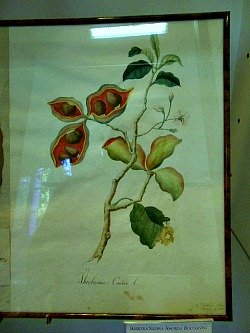
The Work of Antonio Bertoloni
In the first half of the 19th century, Bologna Botanical Garden was influenced by the work of Antonio Bertoloni (1775-1869), Professor of Botany and Prefect of the Garden for 53 years, who increased the collections especially by introducing plants of American origin (in the image above is shown a botanical drawing of Theobroma cacao – the cocoa plant – from Bertoloni's herbal, also in the Botanical museum).
Bertoloni's major contribution, however, remains the Flora Italica – an important work documenting the native Italian flora (although the country was not yet unified, at that stage). This monumental achievement – 10 volumes, which took about 40 years of preparation and study to complete – is in many ways still unsurpassed, if one considers that all the species described were accurately studied, and the indications on the places of collection or where the plants can be found are based on specimens collected by Bertoloni himself or sent to him by other botanists: all these specimens form what is still known today as Hortus Siccus Italiae, one of the country's foremost dried Herbaria.
This Herbarium contains specimens coming from all parts of the Italian peninsula, as well as Sicily, Sardinia, Corsica and the minor islands; in origin, it contained 803 genera and 4,211 species – all diligently desiccated and still perfectly conserved. Each specimen carries information regarding not just its scientific name but also the place and time of collection, the name of the collector and a reference to the volume where the plant is described.
The Bertoloni collection still constitutes today the core nucleus of the Bologna Botanical Garden Herbarium, and it is one of Italy's most important works of this kind both from a scientific and a historic point of view. But Bertoloni was not only a great scholar at national level; he also was quite knowledgeable on the flora of other parts of the world: he discovered several species, and some of them were dedicated to him. He also made a significant contribution at organizing the botanical knowledge of his time, even though he did not set forth any original idea (mainly because he refused to let go of the Linnaean sexual system, which was becoming outdated). Among his main publications, however, one has at least to include the Flora guatimalensis (1840), the instalments of the Miscellanea botanica (1842-1851) and the Plantae Novae Asiaticae (1864-5), in which Bertoloni described a great number of new exotic species.
His son Giuseppe then succeeded Antonio as Prefect of the Garden (from 1869 to 1878), followed by Federico Delpino (Prefect from 1884 to 1895); the latter was also one of the first Italian naturalists to accept Darwin’s theory on evolution. The large female Ginkgo which can still be found in the front half of the garden was studied by Delpino, who was the first to recognise the close evolutionary relationship between Ginkgo and conifers (in those times there was also a large male specimen of this species, which was unfortunately felled during an air raid in 1944).
During all those years, Bologna Botanical Garden remained in close contact with other European Botanical Gardens, and the Prefects established relationships with the foremost botanists of the time, from whom they often received plants and seeds. This testifies to the fact that Bologna Botanical Garden was still an important institution, firmly included within the framework of botanical studies at European level.
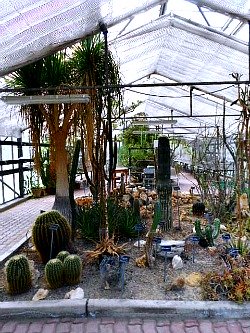
The Botanical Garden Today
After Delpino, however, Bologna Botanical Garden went through a phase of decline, and we have to reach the 20th century in order to see some positive change, with the realization of the four new glasshouses.
Also, according to Roberto Savelli – Head of the Botany Institute from 1938 to 1965 – in more recent years Bologna Botanical Garden went through a period of stagnation and neglect for a considerable time, and during this phase it was nothing more than a small, heterogeneous collection of local species mixed with exotic ones. Part of the garden was covered by a thick natural vegetation which was not subjected to any human intervention, where the plants competed for light and space.
Thanks to its reorganisation, however – begun a few years ago and still underway – Bologna Botanical Garden looks very different today. The main elements underlying its present structure are single collections of high value and the reconstruction of natural habitats in which plant species are associated as they would be found in nature. Indeed, the functions of a modern Botanic Garden are mainly educational and – contrary to historical gardens – directed to the public.
With regard to the collections, the most noteworthy one is that of succulent plants: it is one of the largest in Italy, and it was created in the last few decades thanks to the efforts of Giuseppe Lodi, Professor of Botany (see a picture of the Cacti collections in the image above). Two other hothouses contain tropical plants, amongst which are some beautiful epiphytic orchids and several European and exotic carnivorous plants.
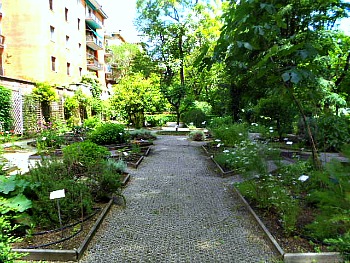
Outdoors, the front part of the garden overlooking via Irnerio is partially ornamental but it also hosts numerous trees and shrubs of scientific and educational interest. The largest portion of the garden, however, extends at the back of the buildings of the Biology Department, up until the bastions of the city, and it is mostly dedicated to the reconstruction of natural habitats: the area of the medicinal herbs, once known as simples – or, better still, simple principles; that is, the drugs directly extracted from the plants (from which derives the denomination Garden of the Simples – Giardino dei Semplici – which is portrayed in the image above); two artificial ponds with aquatic plants, and the woodland consisting mainly of broadleaved species of temperate climates. In the latter zone there are several monumental tree specimens – in particular an old Sweet Gum (Liquidambar styraciflua; pictured below), a Taxodium distichum, a Pistacia atlantica and several majestic poplars. Finally, a new habitat is currently being established and corresponds to a submerged forest of the Po valley plains; next to it is a pond with the vegetation typical of swamps and marshes.
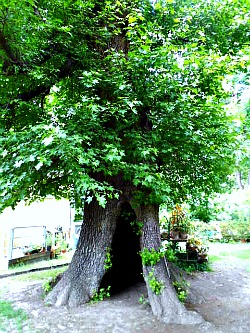
Along the artificial slope that rises towards the city bastions several other vegetation groups are present: Mediterranean plants from hot and arid zones; species from the habitats of warm, low-altitude regions and others from cooler mountain areas (such as the beech grove), found higher up in the Apennines around Bologna. Specimens of high-altitude mountain flora and of the Gessi bolognesi are currently being planted as well, in a newly established Rock Garden that also has a small section on Alpine Plants (as it can be seen in the image below). Let us now go through a brief description of the different areas that compose Bologna Botanical Garden in more detail.
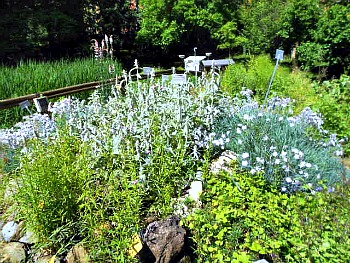
Visit of the Garden
Today, Bologna Botanical Garden follows two criteria which are quite different from those pursued in historic times: on one hand, the presentation of single collections of particular value; on the other hand, the reconstruction of natural habitats, in which the plants are gathered and presented in a similar way as they would be seen in nature.
The Front Garden
This is the area located in front of the main building, just beyond the entrance gate on via Irnerio. It mainly gathers up woody plants widely cultivated in European Botanical Gardens; particularly, there are gymnosperms belonging to the genus Abies, Araucaria, Cephalotaxus, Ginkgo, Metasequoia, Picea, Pinus and Taxus. In addition to these, there are shrubby and herbaceous plants with beautiful and exuberant blossoms.
The Back Garden
The largest portion of the garden – which extends at the back of the buildings of the Biology Department up until the old city walls – is dedicated to thematic collections and to the reconstruction of natural habitats; its main areas are:
Grove of Broadleaved Trees
This is a little raised area with several woody plants; some of them – recently introduced – come from the woods of the hills surrounding Bologna (both the Gessi bolognesi and the Apennines around Bologna). Herbaceous plants have also been added, in agreement with the themes developed by woody vegetation.
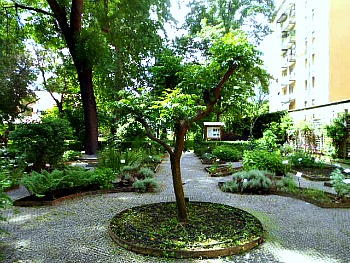
Medicinal Plants
This section includes many medicinal and aromatic plants of the Italian flora. Within the area there is an artificial pond with aquatic plants also belonging to the spontaneous Italian flora. Another area dedicated to medicinal plants is the Garden of the Simples (Giardino dei Semplici): this one retrieves the plan of the first Bologna Botanical Garden, as established by Ulisse Aldrovandi in 1568 (although in a different location); in it, the plants are arranged – following a didactic intent – in accordance with their most common medical use (see picture above).
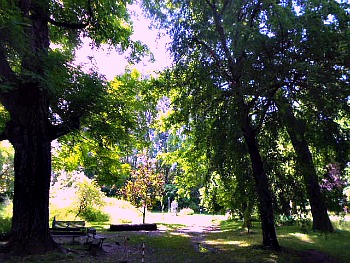
Wood-park
This is a vast lawn with woody plants: the Arboretum, which forms the bulk of the garden; it mainly hosts broadleaved trees of temperate climates, distributed along the walking routes (see a general image above). Some of these plants are very ancient – authentic woody monuments, like the large specimens of Juglans cinerea, Quercus robur and Liquidambar styraciflua – some others are not so old, but they display nevertheless monumental shapes (such as the Sophora japonica shown in the picture below).
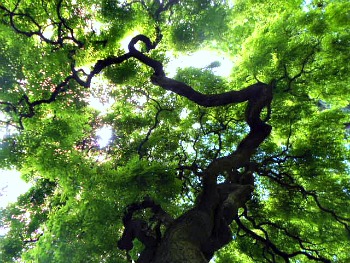
Submerged Forest of the Plains of the River Po and Pond
This part includes a pond with typical wetland vegetation, a peripheral zone of half-submerged plants, a moist prairie and the reconstruction of meso-hygrophilous forests of poplar and willow trees, with white and black poplar as prevailing woody species (an image of the wetland area representing the submerged forest typical of the plains of the River Po is shown below). In this section there is also a little, sunny artificial pond with exotic aquatic plants.
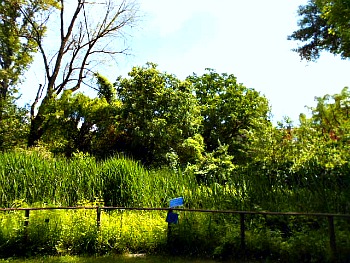
Bastions (City Walls)
This part is located on the northern side of the garden, and it is the only section to develop on a slope (in fact, originally, this raised mound was artificially created with rubble). It is bordered by the old town walls and it contains many deciduous woody plants, almost all native and representative of the flora of the Apennines around Bologna. The oriental side has an arid micro-climate and it is more exposed to the sun; it contains therefore a collection of shrubs and evergreen trees typical of the Mediterranean region, while the western side is fresher and it hosts a number of representatives of woodlands usually found at higher altitudes.
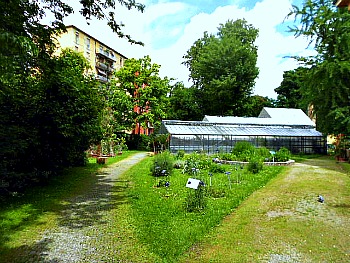
Greenhouses
Within the garden there are two greenhouses open to the public (an image of the greenhouse compound is presented above); in fact, these represent the highlight of Bologna Botanical Garden. The first one is characterised by a collection of tropical plants; amongst them are some well-known food plants (Tamarind, Pepper, Cocoa, Ginger, etc.), species of economic importance (Cotton, Tobacco, etc.) and some specimens of Fern, Bromeliads and epiphyte Orchids. The second greenhouse contains a rich collection of succulent plants – the undisputed gem of Bologna Botanical Garden (see, for instance, an impressive specimen of Euphorbia grandicornis in the picture below). Another little greenhouse – not open to the public – hosts a collection of carnivorous plants.
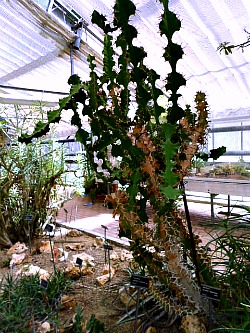
Return from Bologna Botanical Garden to Emilia-Romagna
Return from Bologna Botanical Garden to Italy-Tours-in-Nature
Copyright © 2019 Italy-Tours-in-Nature

New! Comments
Have your say about what you just read! Leave me a comment in the box below.